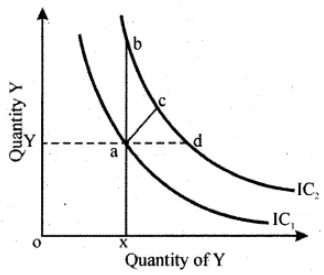The main characteristics of indifference curve are the following:
(i) Indifference Curve has a Negative Slope : The negative slope of an indifference curve implies that the two goods are substitutes for one another. Therefore, if quantity of one commodity decreases, quantity of the other commodity must increase, if the consumer has to stay at the same level of satisfaction.
(ii) Indifference Curves are Convex to Origin : The convexity of indifference curves implies:-
(a) That the two goods are important substitutes for one another.
(b) That the marginal rate of substitution between the two goods decreases as a consumer moves along an indifference curve.
Convexity of the indifference curve is based on the postulate of diminishing marginal rate of substitution.
(iii) Indifference Curves Do Not Intersect Nor are Tangent to One Another : If two indifference curves intersect or are tangent to each other, it would mean that an indifference curve indicates two different levels of satisfaction or that two different combinations – one being larger than the other, produce the same level of satisfaction. Such conditions are impossible if consumer’s subjective valuation of a commodity is greater than zero. Also, if two indifference curves intersect, it would mean violation of consistency or transitivity assumption in consumer’s preferences.

Let us now see what happens when two indifference curves IC1 and IC2, intersect at point B. Consider two other points – point F on indifference curve IC1 and IC2, and point E on indifference curve IC2, both falling on vertical line.
Points B, F.and E represents three different combinations of commodities X and Y. Note that combination B is common to both the indifference curves, it implies that, in terms of utility,
B = F
B = E
F = E
But, if F equals E, it would mean that in terms of utility,
OD of X + FD of Y = OD of X + ED of Y
Since, OD of X is common to both the terms, it means that FD of Y is equal to ED of Y.
But this is not so. Figure shows FD > ED. Therefore, combination F and E cannot be equal in terms of utility in the objective introspection of the consumer. The intersection, therefore, violates the transitivity rule which is a logical necessity in indifference curve analysis.

(iv) Higher Indifference Curves Represent a Higher Level of Satisfaction Than the Lower Ones : An indifference curve placed above and to the right of another represents a higher level of satisfaction than the lower one. The reason is that an upper indifference curve contains all along its length a larger quantity of one or both the goods than the lower one. And, a larger quantity of a commodity is supposed to yield a greater satisfaction than the smaller quantity of it, provided MU > 0
Comparison of Lower and Upper Indifference Curves
For example, consider the indifference curves IC1 and IC2. The vertical movement from point a on the lower indifference curve, IC1, to point b on the upper indifference curve, IC2, means increase in quantity of Y by ab, the quantity of X remaining the same (OX). Similarly, a horizontal movement from point a to d means a greater quantity of commodity X, quantity of Y remaining the same. A diagonal movement from point a to c means larger quantities of both X and Y. Unless the utility of additional quantities of X and Y are equal to zero, these additional quantities will yield additional utility. Therefore, the level of satisfaction indicated by the upper indifference curve (IC2) would always be greater than that indicated by the lower indifference curve (IC1).